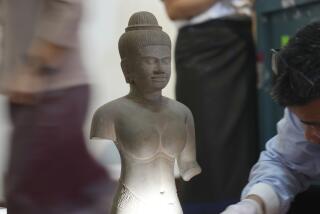DANCE REVIEW : Cambodian Culture Thrives in ‘Dreams’
- Share via
LONG BEACH — Out of the nightmare of 20th-Century Cambodia (now Kampuchea) comes “Angkor Dreams,” an evocation in music and dance of the traditional culture of this ravaged nation.
Seen at its United States debut, Thursday in the Long Beach Terrace Theater, the company and its program emerged from a refugee camp along the Thai-Kampuchean border. That makes its sense of Khmer tradition quite different from that of artists rebuilding their culture inside Kampuchea or those sustaining a Cambodian heritage within our own borders.
Age 10 to 21, these Cambodian refugees dance, and dream, in isolation--in one sense hostages to history and in another a living time capsule.
Trained by Voan Savoy of the Khmer Royal Corps Ballet and Meas Van Roen of the Royal University of Fine Arts, they reflect a serene, classic refinement that fell under siege in their homeland before most of them were born.
Except for the opening architectural slide show and the Apsara ritual (five women depicting ancient temple statues), the Thursday program focused not on the glories of Angkor or court entertainment but on village life.
In the children’s Harvest Dance, for instance, a rich combination of pantomime, character and formal elements mixed with vibrant singing in a rhythmic celebration of rural labor.
The Fishing Dance also featured detailed gestural portraits of work activities--the men trapping fish in cage-like baskets, for example--along with a deft flirtation duet for Chein Sokun and Lak Paallan.
Even in these folk dances, the company’s mastery of supple, intricate hand and head motion revealed the quality of their training.
As the main event of this 3 1/2-hour performance, the company offered “Tom Tiev,” a lyric drama about star-cross’d lovers that became periodically interrupted by extended comic interludes for Sopan Pin and Verey Sebol.
Dominating everyone, however, Van Vannak brought a devastating fusion of grace and intensity to the role of the suffering heroine.
With the same delicacy she had revealed in the Apsara dance, she made her love, her pain, her sweetness of character sustain involvement even through static passages and the uneven performances of her colleagues. A major artist at 21.
Although the slide-show featured English narration, the rest of the program did not--and no program sheets were available in any language.
More to Read
The biggest entertainment stories
Get our big stories about Hollywood, film, television, music, arts, culture and more right in your inbox as soon as they publish.
You may occasionally receive promotional content from the Los Angeles Times.










